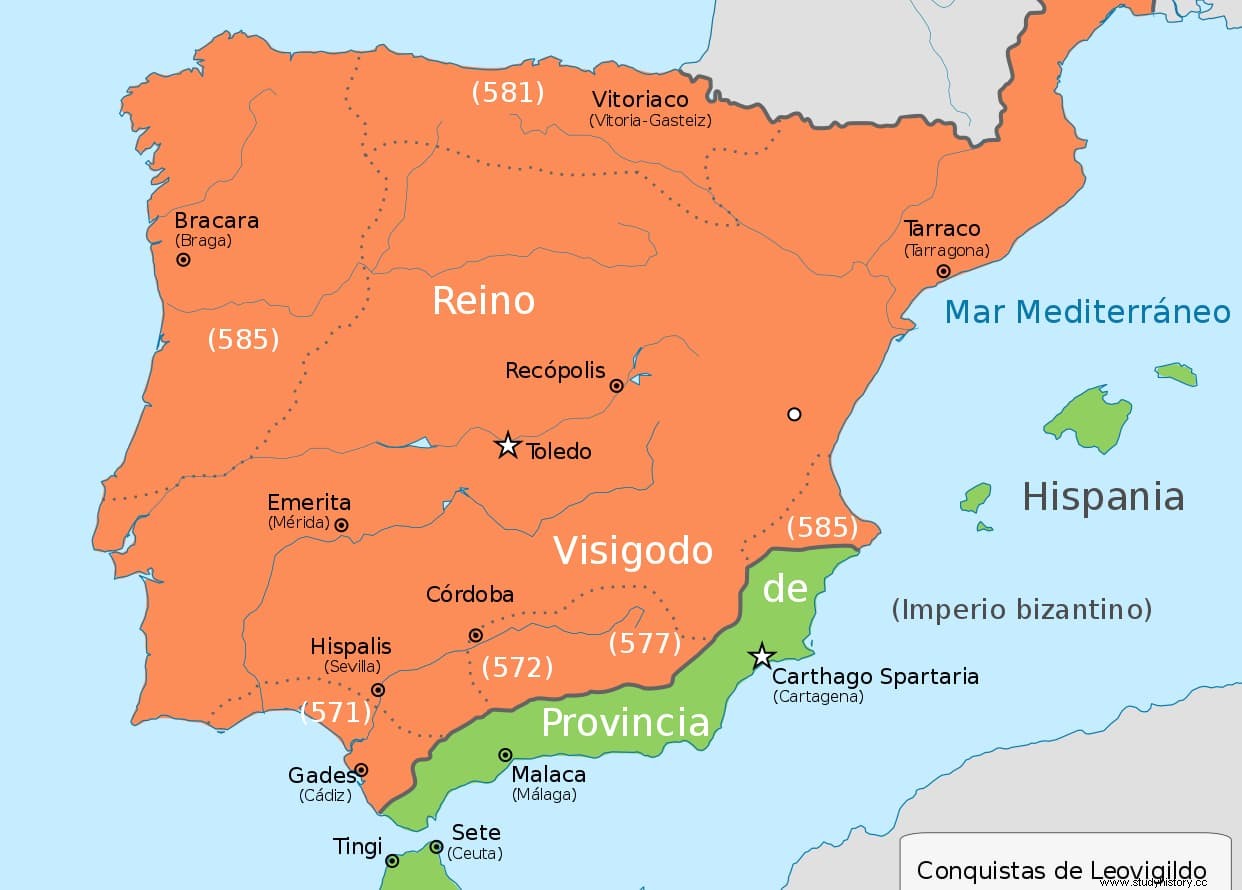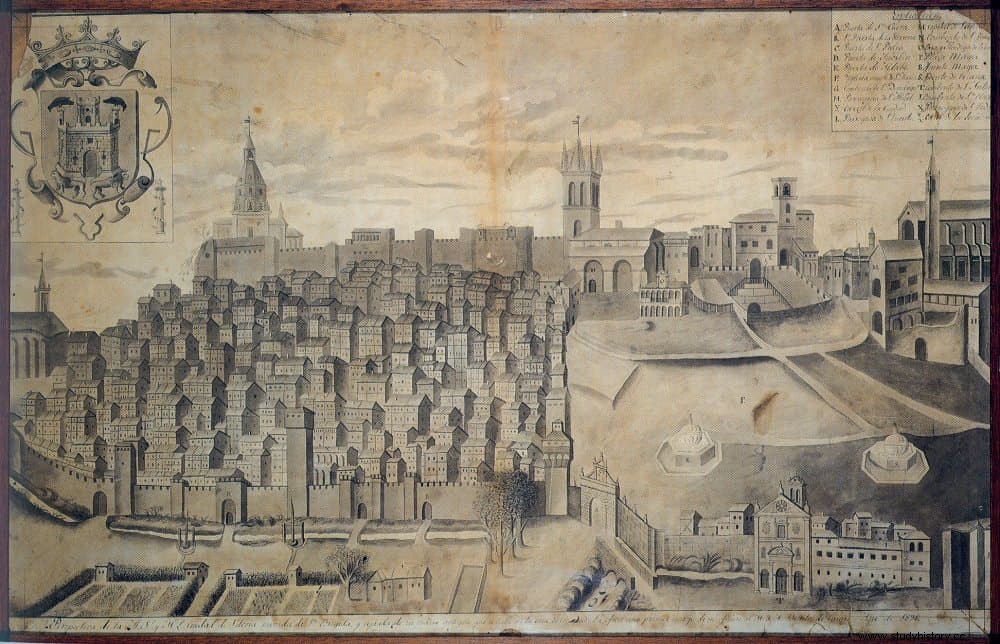In the year 507, the pressure of the Franks caused the Visigoths, who until then had occupied and controlled southern Gaul and much of the north of the Iberian Peninsula, to move to Hispania en masse. That year is taken as the founding of the Visigoth Kingdom of Toledo, which would not be consolidated until the reign of Leovigildo (568–586) with the incorporation of the Swabian kingdom of Galicia and the northern Cantabrian fringe.
The Visigoth domain of the peninsula would last for 196 years, until the Muslim conquest began in 711. During all that time he had to face the Merovingian threat from the northeast and the Byzantine threat from the Mediterranean coast. The almost permanent state of war prevented the Visigoths from stopping to found new cities, with only a few exceptions (only one is confirmed and the others are doubtful). Even so, the Visigoths will be the only founders of new cities in Western Europe between the 5th and 8th centuries.
Reccopolis
In the year 578 Leovigildo directs the last Arian kingdom that emerged from the decomposition of the Western Roman Empire. To assert his independence from the Merovingians (whom he had just defeated) and the Byzantines, he decides to adopt Roman imperial attributes:minting coins with his name and founding cities.

It is in this context that it promotes the creation of a new city in Cerro de la Oliva (1.5 kilometers from Zorita de los Canes in Guadalajara), dominating a wide agricultural plain next to the course of the Tagus River and the Sierra de Altomira.
He names it Reccopolis (in Latin, Recópolis in current Spanish), without the researchers agreeing on whether the etymology comes from his son Recaredo or from rexopolis (city of the king). In it he tries to imitate the urban layout of Constantinople, endowing it with walls with monumental gates, aqueducts, churches and its own royal palace, which extend over its 33 hectares of surface.
The Muslim occupation did not modify the general urban structure, but by the 9th century it was abandoned for the benefit of Zorita de los Canes, for whose new buildings Reccopolis was used as a quarry. After a brief Christian repopulation between the end of the 11th century and the beginning of the 15th, the city would be definitively abandoned.

Until it was discovered in 1893 by the archaeologist Juan Catalina García López. The first systematic excavations would have to wait until 1945, by Juan Cabré. Traces of towers were found every 30 meters in the walls, markets and commercial and residential districts, and even the building where coins were minted. The palace, located in the upper part, had two floors and was connected to a palatine chapel in the Byzantine style. As for the aqueduct, it is the only one discovered to date from the Visigoth period.
The Reccopolis excavations continue, and the site is included in the Archaeological Park that can be visited and has a museum and interpretation center.
Victoriacum
Leovigildo himself would found a new city three years later, in 581, after his victory over the Vascones. Juan de Biclaro tells it in his Chronicon written around 589:
Juan de Biclaro was a Gothic priest born in what is now Santarém (Portugal), who trained in Constantinople and upon his return was exiled by Leovigildo to Barcino (Barcelona). Around 585 he was pardoned by the king and appointed bishop of Gerunda (Girona).

The problem is that researchers do not agree on the location of that city. Some think that, given the similarities of the name, it could be the Alava capital of Vitoria. Others identify it with the Iruña-Veleia site, 10 kilometers west of Vitoria, and of Roman origin. No Visigothic remains have appeared in the province of Álava that could have been associated with this city of Victoriacum, so the debate continues only in etymological terms.
However, it is curious that, when Sancho VI of Navarra founded the city of Vitoria in 1181 in the place previously called Gasteiz, he points out in the population jurisdiction granted:
Calling the city Nueva Vitoria and not just Vitoria. Which possibly has nothing to do with the existence of Leovigild's Victoriacum, but who knows.
Oligicus / Ologite
In February of the year 621 the Visigoth king Sisebuto died in strange circumstances in Toledo being succeeded by his son Recaredo II, just a child, who would not live beyond the month of April of the same year. This led to the ascent to the throne of his uncle, General Suintila.

That same year Suintila defeated the Vascones, who threatened Tarraconense, and made numerous prisoners and hostages among them. With them as labor he founded and built a new city, as Isidore of Seville recounts in his Historia de regibus gothorum . He called it Oligicus or Ologite (the current Olite in Navarra, located 42 kilometers south of Pamplona). The objective was to establish a line of fortified positions, next to Vitoria, in front of the Basques.
However, although Isidore's statement was taken for granted for many centuries, archaeological excavations in Olite brought to light remains of the Roman walls and numerous epigraphic finds that would show that the city is much older. In 2011 an inscription appeared in Sansomain (15 kilometers from Olite), dated by Professor Javier Velaza, from the University of Barcelona, in the 12th century. The heavily damaged inscription reads […]eologite[…]eon per[…]svhinthilanem Regem (which Velaza translated as Olite nuevo por el rey Suintila ).
Baiyara
In the Kitab al-Rawd al-Mitar (The book of the fragrant garden), geographical dictionary of Al-Andalus written between the 13th and 15th centuries, it is mentioned that the Muslim city of Baiyara had been founded by Recaredo:

Isidore of Seville affirms the same in book XV of his Etymologies . The location of this city is unknown because there is no archaeological evidence, although it is usually associated with the current Cordoban town of Montoro (the ancient Roman Epora). In fact, one theory states that the castle of Montoro was built using the ruins of Baiyara as a quarry. And that the place name Montoro would derive from Mon(te Go)thorum , the Mount of the Goths.
